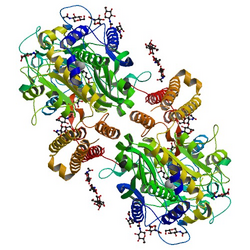Prostataspezifisches Membranantigen
| Prostataspezifisches Membranantigen | ||
|---|---|---|

| ||
|
Vorhandene Strukturdaten: siehe UniProt-Eintrag | ||
| Masse/Länge Primärstruktur | 750 Aminosäuren | |
| Sekundär- bis Quartärstruktur | nichtkovalentes Heterodimer[1] | |
| Bezeichner | ||
| Externe IDs | ||
| Enzymklassifikation | ||
| EC, Kategorie | 3.4.17.21, Carboxypeptidase | |
| Reaktionsart | Hydrolyse | |
| Substrat | Peptide | |
| Vorkommen | ||
| Homologie-Familie | Hovergen | |
Prostataspezifisches Membranantigen (PSMA) (Synonyme: Glutamatcarboxypeptidase II, NAALADase I = N-Acetyl-L-aspartyl-L-glutamatpeptidase I, Folathydrolase I) ist ein membrangebundenes Glykoprotein. PSMA hat die Funktion eines Enzyms. Es handelt sich um eine Carboxypeptidase, die vom C-Terminus aus Glutaminsäure abspaltet. Beim Menschen findet sich das für PSMA codierende Gen auf Chromosom 11 Genlocus p11.12.[2]
Beschreibung[Bearbeiten | Quelltext bearbeiten]
PSMA kommt auf normalen Prostatazellen und Prostatakrebszellen vor. Des Weiteren findet es sich auf Zellen der Neovaskulatur (neugebildeten Gefäßen) anderer solider Tumorarten. Mit dem Progressions- und Metastasierungsgrad nimmt die Expression von PSMA zu.[3] Durch die hohe Spezifität stellt es als Tumormarker ein ideales Zielantigen für neue Therapieansätze gegen das Prostatakarzinom dar.[4] Für diagnostische Zwecke können PSMA-spezifische monoklonale Antikörper bei der Positronenemissionstomographie verwendet werden.[5]
Das humane PSMA besteht aus 750 Aminosäuren. Das unmodifizierte Polypeptid hat eine molare Masse von 84 kDa. Je nach Gewebetyp und Spezies unterliegen 10 bis 30 % davon einer posttranslationalen Modifikation.[6] Die molare Masse liegt dann typischerweise bei etwa 100 kDa.[7]
Siehe auch[Bearbeiten | Quelltext bearbeiten]
Einzelnachweise[Bearbeiten | Quelltext bearbeiten]
- ↑ N. Schülke, O. A. Varlamova u. a.: The homodimer of prostate-specific membrane antigen is a functional target for cancer therapy. In: Proceedings of the National Academy of Sciences. Band 100, Nummer 22, Oktober 2003, S. 12590–12595, ISSN 0027-8424. doi:10.1073/pnas.1735443100. PMID 14583590. PMC 240662 (freier Volltext).
- ↑ FOLH1 Bei: genenames.org abgerufen am 24. Juni 2013.
- ↑ M. I. Davis, M. J. Bennett, L. M. Thomas, P. J. Bjorkman: Crystal structure of prostate-specific membrane antigen, a tumor marker and peptidase. In: Proceedings of the National Academy of Sciences. Band 102, Nummer 17, April 2005, S. 5981–5986, ISSN 0027-8424. doi:10.1073/pnas.0502101102. PMID 15837926. PMC 556220 (freier Volltext).
- ↑ P. Bühler, P. Wolf, U. Elsässer-Beile: Targeting the prostate-specific membrane antigen for prostate cancer therapy. In: Immunotherapy. Band 1, Nummer 3, Mai 2009, S. 471–481, ISSN 1750-7448. doi:10.2217/imt.09.17. PMID 20635963. (Review).
- ↑ M. R. Feneley, H. Jan u. a.: Imaging with prostate-specific membrane antigen (PSMA) in prostate cancer. In: Prostate Cancer and Prostatic Diseases. 2000; 3: S. 47–52. doi:10.1038/sj.pcan.4500390. PMID 12497162.
- ↑ C. Barinka, P. Sácha u. a.: Identification of the N-glycosylation sites on glutamate carboxypeptidase II necessary for proteolytic activity. In: Protein science. Band 13, Nummer 6, Juni 2004, S. 1627–1635, ISSN 0961-8368. doi:10.1110/ps.04622104. PMID 15152093. PMC 2279971 (freier Volltext).
- ↑ Prostataspezifisches Membranantigen. In: Online Mendelian Inheritance in Man. (englisch)